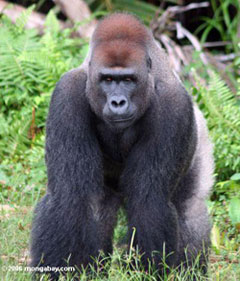Military technology uses satellite signals to catch poachers
SUNY College of Environmental Science and Forestry
May 2, 2007
Wild animals sought by poachers for their skins, meat and bones have a new means of protection developed by a visiting scholar at the SUNY College of Environmental Science and Forestry (ESF).
Steve Gulick, an electrical engineer who calls himself a “biologist wannabe,” has designed a metal detector specifically to pick up the presence of poachers’ weapons and send an electronic signal, via satellite, to law enforcement authorities.
“Based on satellite communication, you can find out about events anywhere in the world within a few minutes of them happening,” Gulick said.
The device he developed, which he calls TrailGuard, can be buried along trails used by both animals and their human predators, he said. The device uses technology similar to that found in airports to detect metal, then sends a signal to a satellite that redirects the message to park personnel working at a central headquarters or in the field.
 Conservationists are using military technology to catch poachers in the act, according to an article published in the December 9, 2006 issue of New Scientist. The article says wildlife managers are using small seismic detectors developed by New York City-based Wildland Security, a firm that builds sensors for detecting wildlife crime.
Commercial hunting is decimating wildlife populations across the tropics and may be one of the gravest threats presently facing rainforests, reports a series of studies published in the May issue of the journal Biotropica. The research reveals that large-scale loss of wildlife is already affecting forest health and regeneration. |
“These can be buried alongside a trail and they give out a silent signal,” Gulick said. “Poachers don’t know they’re being detected.”
The device picks up the presence of weapons such as machetes, assault rifles or shotguns. Armed law enforcement workers can be equipped with transponders that send a specific signal of their own so they will not be mistaken for poachers.
Gulick said he simply adapted existing technology, long used by the military to track movements of enemy troops, to the field of conservation. “It was purely a transfer of technology,” he said. “There’s nothing novel about the technology and it’s not risky.”
The remote metal detector could be a valuable tool for park rangers charged with patrolling vast areas of wildlife habitat. Gulick describes the detectors as a cost-effective way to increase the effectiveness of human resources.
Gulick has spent the last year at SUNY-ESF as a visiting scholar, working on TrailGuard with funding from the U.S. Fish and Wildlife Service. The devices have been tested in a national park in the Democratic Republic of Congo, and Gulick is preparing for a trip later this month to Nouabale-Ndoki National Park in the neighboring Republic of Congo, where TrailGuard will be further tested.
He said the technology could also be used to protect snow leopards in Russia, jaguars in Costa Rica, and giant tortoises in the Galapagos Islands.
Gulick first worked in Africa in 1992, researching infrasonic (low frequency) and seismic communication among elephants. He became involved in anti-poaching efforts, combating both the “bushmeat trade” in which animals are killed for their meat, and the poachers that illegally serve the larger commercial market.
“They have huge areas to protect and limited manpower,” Gulick said, noting a single park in Kenya, Tsavo National Park, is the same size as the nation of Israel. “Essentially, the only time they can be sure of finding someone is if they go out based on information supplied by informants.”
Patrols often arrive to find the results of poaching — piles of rotting animal corpses — while the human offenders are long gone.
Said Gulick: “At the time I was in Africa, I would have felt very safe if I was a poacher.”
This is a modified news release from SUNY College of Environmental Science and Forestry .







